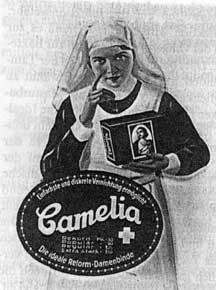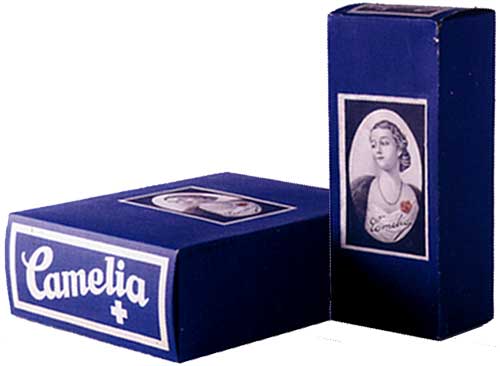More Camelia ads:
1920s (Germany),
1930s
(Germany), 1940/42
(Germany, with underpants made from sugar
sacks, 1945/46), 1952
(Australia), 1970s
(France), 1990
(Germany) - Underpants
directory
Booklets
menstrual hygiene companies made for girls,
women and teachers - patent
medicine - a list
of books and articles about menstruation - videos
See a Kotex ad
advertising a Marjorie May booklet.
See many more similar booklets.
See ads for
menarche-education booklets: Marjorie May's Twelfth
Birthday (Kotex, 1932), Tampax tampons (1970,
with Susan Dey), Personal
Products (1955, with Carol Lynley),
and German o.b.
tampons (lower ad, 1981)
And read Lynn Peril's series about
these and similar booklets!
Read the full text of the 1935 Canadian edition
of Marjorie May's Twelfth Birthday, probably
identical to the American edition.
More ads for teens (see also introductory page
for teenage advertising): Are you in the know? (Kotex napkins and Quest
napkin powder, 1948, U.S.A.), Are you in the know? (Kotex napkins and belts,
1949, U.S.A.)Are
you in the know?
(Kotex napkins, 1953, U.S.A.), Are you in the know? (Kotex napkins and belts,
1964, U.S.A.), Freedom (1990, Germany), Kotex (1992, U.S.A.), Pursettes (1974, U.S.A.), Pursettes (1974, U.S.A.), Saba (1975, Denmark)
See early tampons
and a list of tampon
on this site - at least the ones I've
cataloged.


|

The Museum of Menstruation and
Women's Health
Former museum – Future – Comic strip about
visit to the museum
Camelia, early disposable
menstrual napkin, boxes
(Monatsbinde), Germany, 1930s
And see one
of the nicest ads
ever
for a product (just my opinion),
Camelia pads.
Imagine
this: a company starts a
menstrual pad factory in a small
town in the Midwest, U.S.A., let's
say where Kotex was made. Now,
what to name it? Hm.
Oh, I know, let's name it after
the flower associated with a famous
prostitute!
NOT!
Well, the
Germans did! Of course,
it was during the Weimar Republic,
in 1926, a famously turbulent and
liberal period–oops!–in German
history. The wh-, um, prostitute
was the heroine of the famous (in
Europe, and in earlier America
where it was known as "Camille")
play "La Dame aux Camélias" ("The
Lady of the Camellias") by
Alexandre Dumas (which Verdi later
morphed into the opera "La
Traviata"–"The Wayward Woman").
Educated Europeans would have
understood the association and
maybe smiled at it. Or felt
guilty. Europeans accepted, and
accept, these things easier than
Americans.
The title
character would show a white
camellia when she was willing to
receive clients and a red one
when - you guessed it - she was
menstruating. Red has
been mostly taboo in American
menstrual advertising (but not with
Camelia!). We certainly
can't hint at the color of the
substance our product is
absorbing, can we? (Some
prostitutes in northern Germany
today show a porcelain dog's
face when they're available and
turn Bowser around to show his
[her?] tail when they're not.
Wait, shouldn't it be the other
way arou- - oh, forget it.)
Look! The boxes are about the
same blue as, um, Kotex blue,
which Kotex modestly (not Modessly)
called
hospital blue! What gives with
this color? That's just what Dr.
Lillian Gilbreth wondered in her report
to Johnson & Johnson (maker of
Kotex's competitor Modess, which
also–Oh, no!–used Kotex blue, here!)
in 1928.
Camelia was an early German
disposable pad. Hartmann,
of Germany, made probably the
first commercial disposable
anywhere. About the same time
(1890s) Johnson & Johnson
probably made the first American
disposable, Lister's
Towels.
And another thing that hasn't
happened in America: an exhibit about
menstruation in a government
museum! (See the catalog
particulars in tiny type,
right below.) Yes, I had
an exhibit
in
my house for four years but
can you imagine the Smithsonian
having such an exhibit? But Norway did
too.
I adapted the pictures and
gleaned information from the
catalog "Menstruation:
Monatshygiene im Wandel von 1900
bis heute," Text und
Katalog: Sabine Zinn-Thomas und
Walter Stolle. Eine Ausstellung
des Hessischen Landesmuseums
Darmstadt in der Außenstelle
Lorsch, 26.11.1998 bis 31.7.1999.
My translation: "Menstruation:
Changing menstrual hygiene [in
Germany, mostly] from 1900 to
today [1998]." Text and catalog:
Sabine Zinn-Thomas and Walter
Stolle. An exhibition of the
Hessian State Museum, Darmstadt,
in the branch at Lorsch, from
November 26, 1998 to July 31,
1999.
|
What? There
really was a lady of the
Camellias? Read
this short review of a biography
of Marie Duplessis (from The
New Yorker, 5 August 2013):
The Girl Who Loved Camellias,
by Julie Kavanagh (Knopf). The great
French courtesan Marie Duplessis was
muse to Alexander Dumas fils and
Franz Liszt, and, via Dumas, Verdi's
inspiration for "La Traviata."
Fleeing a dreadful childhood in
Normandy, Duplessis bounced from job
to job – maid, laundress, apprentice
at an umbrella shop – before arriving
in Paris, where she found the work
that suited her best. While her
profession alienated her from the
women of society, her natural charm
and glamour made her irresistible to
men. Tracing Duplessis's many
affairs, Kavanagh brings
eighteen-forties Paris vividly to
life. Denied a formal education,
Duplessis proved a quick study, and
her command of the works of Balzac,
Byron, Molière, and Cervantes added
to her allure. She inspired a wealth
of imaginative accounts, and was
only twenty-three when she died, of
consumption [tuberculosis], in 1847.
|
 |
Left:
The prostitute
heroine of the
play "La Dame
aux Camélias"
wears the red camellia that shows she's menstruating and not
available.
This picture
came glued to
the boxes (below
the next
picture). She
also graces the
cover of a Dutch
booklet
promoting
Camelia.
Just
below:
There seems to
be a bad
woman-good
woman
connection
between the
Camelia lady
(left) and this
nurse in an
earlier Camelia
ad, below. The
nurse's uniform,
after all,
derived from a
nun's habit. It's almost as if she's wagging her finger at the
harlot.
Read more about
the nurse here.
Don't both
pictures
enforce the Außenseiter
- outsider
- side of
menstruation
as shown here?
|
 |
|
|
Below:
The boxes - these are two
different sizes - allowed a woman
to store them with a blank side
facing the viewer,
concealing the contents. In the
1920s, American college women wanted
menstrual pad boxes that had a
similar design. Camelia early on
put a slip
of paper inside the box
that the customer could bring to a
female clerk; the slip's text
asked for a box of Camelia. This
was similar to the maker's
suggestion that Kotex boxes sit on
the counter
next to a coin box. No need to
exchange words in either case.
|
 |
See one of
the nicest ads
ever
for a product (just my opinion),
Camelia pads.
More Camelia ads:
1920s
(Germany), 1930s
(Germany), 1940/42
(Germany, with underpants made
from sugar sacks, 1945/46), 1952
(Australia), 1970s
(France), 1990
(Germany) - Underpants
directory
© 2006, 2016 Harry Finley. It is
illegal to reproduce or distribute
any of the work on this Web site
in any manner or
medium without written permission
of the author. Please report
suspected violations to hfinley@mum.org
|
|